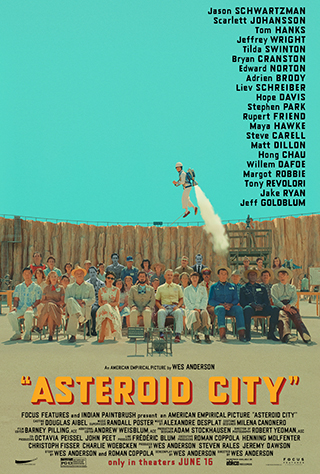Movies

New Releases • A-D • E-H • I-P • Q-Z • Articles • Festivals • Interviews • Dark Knight • Indiana Jones • MCU
Asteroid City
Trailer: Focus Features
Asteroid City
Directed by Wes Anderson
Rated PG-13
Cratered 16 June 2023
#AsteroidCity
Asteroid City has its charms, but it’s mostly a dull place to visit.
French Press International

Maybe The French Dispatch seduced this writer with its focus on the crafts of writing and journalism. It was a tour de force of creativity that popped with ideas and energy.
This time, Anderson turns to the world of stage theatre and — despite mining so many of the same trappings — Asteroid City craters.
The story revolves around a long-running stage play being performed for a TV broadcast back in the 1950s. Bryan Cranston plays the TV host, setting the stage, so to speak, both for the show to be televised and the movie wrapped around it. The play takes place in the titular Asteroid City, population 87. It’s in the middle of the middle of nowhere. It’s September 1955. Nearby, atomic bomb tests go off and there’s also a sci-fi vibe as mystery surrounds an alien visitor and the theft of a very, very small, baseball-sized asteroid.
Of course, there’s also a wide array of characters.
Edward Norton is Conrad Earp, the playwright behind Asteroid City.
Augie Steenbeck (Jason Schwartzman) is a father to a son and three little witches — er, girls. He’s held off telling them their mother died three weeks ago and he’s been carting her ashes around in Tupperware. That ties into a strained relationship with his father-in-law, played by Tom Hanks (the role seems like a good fit for Bill Murray had he not been absent from this production — the first Wes Anderson feature since Rushmore in 1998 to not feature Murray; however, Anderson’s stated Murray was sidelined with Covid and was supposed to play the role ultimately filled by Steve Carell).
Midge Campbell (Scarlett Johansson) is an actress with a troubled soul who engages in a passionless, emotionless relationship with Augie.
Plus, there are a whole lotta other characters, making room for Jeff Goldblum, Liev Schreiber, Tilda Swinton, Adrien Brody, Jeffrey Wright, Matt Dillon, Willem Dafoe, an animated space alien... and the list goes on and on.
Arid Plains Meteorite
As with Dispatch, Anderson plays in black-and-white and color, tinkers with shifting aspect ratios and throws in all sorts of narrative constructs — oftentimes going down into miniscule, nitty-gritty levels of detail to build the world and create a very specific experience. Fitting in with the time, there’s a distinct color palette and color saturation evoking the world of Kodachrome.
Such painstaking efforts would normally be lauded in a movie with ambitions crossing between 1950s Broadway and post-war Americana.
But here Anderson’s formula is overexposed.
It’s about the deadpan delivery of word play that doesn’t necessarily advance a storyline.
It’s about playing with narrative structure and intentionally taking viewers in and out of a storyline.
It’s about quirky characters and settings.
It’s about filmmaking technique and styling.
It’s about character names.
Above all else, it’s about employing an enormous number of actors. So many A-listers drop into a scene to deliver only a few select words (and collect a paycheck, thereby maintaining their health insurance).
Trouble is, regardless of what it’s all about, there’s very little worth taking home.
Scrimmage Plan X
Anderson operates in a cinematic universe all his own, the WACU, as it were, and his niche does not settle into the straightforward.
Perhaps Asteroid City the movie is a rumination on COVID-19 and the pandemic, along with the governmental interference that put so many lives on pause, after all, Asteroid City the location is about as isolated as isolated can get. But this is all thrown into the much more colorful context of space aliens, atom bomb tests, government policies and vintage cars.
It’s funny so much of this is right out of Indiana Jones and the Kingdom of the Crystal Skull. (Interesting side note: Steven Spielberg gets a “thanks” in the end credits, as do Martin Scorsese and Brian de Palma.) To be clear, a nifty little sequence in which a lanky, big-eyed alien cautiously appears in front of a gaggle of stargazers and pockets an asteroid right in front of them is really well done. Like Fantastic Mr. Fox, it’s done through the magic of stop-motion animation, not CGI. Very cute — and it’s also the catalyst for the government to roll in and put Asteroid City under lockdown.
Ultimately, though the characters themselves start to call undesirable attention to their own movie.
One kid is constantly trying to dare people into doing this, that or the other thing. But is he really — through the artful manipulation of Anderson — really daring audiences to like (or maybe not like) his movie?
And then there’s the big confession from Augie. No, it has nothing to do with his wife or her death. It’s about the play. “I still don’t understand the play,” he says.
The response he’s given: “It doesn’t matter.”
So, there it is. Artiness strictly for the creative expression of and sake of artiness.
• Originally published at MovieHabit.com.


